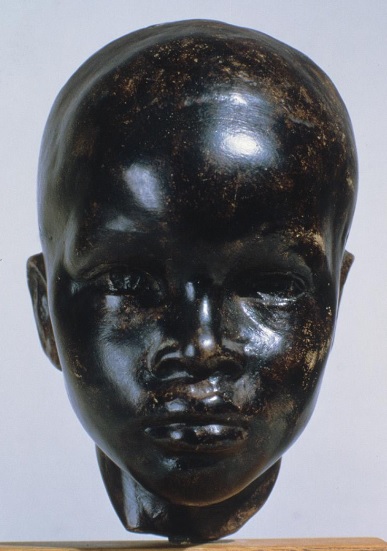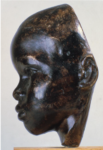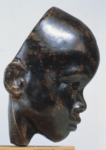


Richmond Barthé
American, 1901-1989
Julius (formerly shown at SBMA as “Head of a Boy”), 1940 ca. (formerly 1930)
plaster of Paris painted with a dark wash
6 1/2 x 4 in.
SBMA, Gift of Ala Story
00.184

Richmond Barthé - undated photo
"All my life I have been interested in trying to capture the spiritual quality I see and feel in people, and I feel that the human figure as God made it, is the best means of expressing this spirit in man." - Richmond Barthé
RESEARCH PAPER
Identity and Description of Object
“Head of a Boy”, the sculpture head of a black youth, was executed in 1930 by Richmond Barthé. Formed from plaster of Paris that is covered with a dark wash, the piece is in fairly good condition with only a few scratches on the right side. It is smaller than life-size, measuring slightly over six inches high and four inches wide. Ala Story donated “Head of a Boy” to the SBMA in 1941. According to Mr. Barthé, the head was modeled after a negro youth, the nephew of the housekeeper of Carl van Vechles. In researching our sculpture, I learned that the Pennsylvania Academy of Fine Arts in Philadelphia has in its collection a full-size bronze head by Barthé of this same youth.
Style
Richmond Barthé was born in Bay St. Louis, Mississippi, in 1901. Of French, Indian, and Negro ancestry, he was brought up in a poor home where Christian values were emphasized. His formal education ended with the sixth grade. In order to augment the meager family income, Barthé worked at various jobs ranging from office boy to butler. He showed an early interest in art and loved to paint and draw, copying any beautiful picture he could find.
The family moved to New Orleans during Barthé's teen years. Influenced by his religious upbringing, Barthé found spiritual inspiration in copying the paintings of the saints in the nearby Church of the Blessed Sacrament. Reverend Harry Kane, the parish priest, took an interest in the self-taught black youth and helped to raise funds, which enabled him to enroll at the Chicago Art Institute in 1924. After four years of study, Barthé produced his first popular work, “The Negro Girl”. His simple, straight-forward style impressed the critics and he received Honorable Mention in the Hermon Awards and won the Eames McVeigh prize from the Chicago Art League. These prizes were the turning point in Barthé's life. He became convinced that his mission in life was to give the world a message through his art.
Barthé's growing fame has met with enthusiastic recognition. His works are found in over 40 museums worldwide. Having experienced poverty, racial discrimination, and now success, Barthé is possessed of rare individuality, which has enabled him to view art in its majestic relation to life. Gradually he has been able to put his skill of craftsmanship at the service of his high idealism. Barthé’s hand and soul move together in his lifelong quest to depict the inner and outer qualities of the black man.
In style, Barthé stands midway between abstract modernism and realism. He moves toward simplification naturally, always keeping the spiritual and rhythmic qualities of his figures. His work is distinguished by great simplicity, conservation, and freedom, which is combined with sensitivity, true depth of perception, and the ability to infuse in his sculptures an element of spirituality.
Content
In the plaster of Paris sculpture “Head of a Boy”, Barthé expresses not only the beautiful but the spiritual. He portrays with simplicity the bold head of a youth, his eyes are deep set, his forehead high. The line of the jaw and other features are smooth yet one feels that Barthé's sensitive fingers understand every sinew and muscle beneath the surface. The work is simple, dignified, and non-stylized. Because of his heritage, Barthé has been particularly interested in portraying his race. He has taken the racial theme of the negro character, ennobled it, and clothed it with dignity in order to express his own moral and religious ideals.
Prepared for the Santa Barbara Museum of Art Docent Council by Ginger Bender, February 1985.
SELECTED BIBLIOGRAPHY
Ames, Winslow, “Contemporary American Artists: Richmond Barthé”, Parnassus, March 1940, v. 12, pp. 10-17.
Cederholm, Theresa Dickson, “Afro-American Artists”, Boston, 1973, pp. 17-19.
Challenger, Josephine S., “A Comparative Study of the Sculpture of Negro Artists Stressing the Spiritual Quality of the Work of Richmond Barthé”, Dissertation, Catholic University of America, August, 1948.
Dover, Cedric, “American Negro Art”, Alfred Knopf, New York, 1976, pp. 69-71.
Fine, Elsa Honig, “The Afro-American Artist”, pp. 129-133.
Harmon Foundation, “Negro Artists: An Illustrated Review of Their Achievements”, New York, 1971, pp. 11-12, 42.
Van Vollton, Carl "Concerning Richmond Barthé”, January 31, 1939, New York.
“Who’s Who in America: Art”, 1982, p. 51.
COMMENTS
African American sculptor and painter. Barthé was raised a devout Roman Catholic Creole. He was also the only African American artist of his generation to consistently portray the black male nude. Although closeted throughout his life, sensual figure such as Stevedore (1937; Hampton, VA, U. Mus.) expose his homosexuality. Barthé’s elementary education ended in 1914. As an adolescent, he skillfully copied magazine illustrations, especially figures. Barthé worked for the wealthy New Orleans Pond family, who summered on the Bay, and in 1917, he moved to New Orleans to become their live-in servant. Barthé had access to the Pond library and art collection, and while in their employment, he began to paint in oil. In 1924, his head of Jesus prompted the Rev. Harry F. Kane to fund the first of four years at the Art Institute of Chicago School, where Barthé studied painting with Charles Schroeder and sculpture with Albin Polasek (1879–1965). He also worked with Motley, Archibald J., Jr. in Chicago and Arthur Lee at the Art Students League, New York, in 1929.
The Negro in Art Week exhibition (1927) at the Art Institute of Chicago included Barthé’s student sculpture. Critical attention from such respected men as Alain Locke changed his focus to sculpture. With a 1929 Rosenwald fellowship, Barthé worked temporarily in Harlem on portraits and figures inspired by black urban popular culture as well as Italian Renaissance masterworks for a Chicago solo show in 1930. The following year, Barthé moved permanently to Manhattan, beginning two decades that marked the height of his productivity.
Beginning in 1932 with the Whitney Museum of American Art’s purchase of The Blackberry Woman, Barthé’s emotive black figures entered important collections such as the Metropolitan Museum (Boxer, 1942) and numerous private collections. Barthé designed an outdoor frieze for the Harlem River Houses while on the Treasury Relief Art Project (1936–9). His major solo show took place in 1939 at the Arden Gallery, New York. The strength of his mature figurative work such as Feral Benga (1935; Newark, NJ, Mus.), a sensitive portrait of the Senegalese dancer, afforded him the first of two consecutive Guggenheim fellowships in 1940. Barthé was also sponsored by the Harmon Foundation.
After completing public monuments for Haiti, Barthé expatriated to Jamaica in 1951 to paint. With limited success at the easel, inspired figures such as Inner Music (1961; Los Angeles, CA, Co. Mus. A.) mark his return to sculpture in the 1960s and the culmination of his oeuvre.
In 1975, following a short residency in Florence, Italy, Barthé returned to the USA and settled in Pasadena, CA, where the actor James Garner was his benefactor until his death.
Bibliography
M. R. Vendryes: Barthé: A Life in Sculpture (Jackson, MS, 2008)
P. C. Black: American Masters of the Mississippi Gulf Coast: George Ohr, Dusti Bongé, Walter Anderson, Richmond Barthé (Jackson, MS, 2009)
- Margaret Rose Vendryes, Grove Art Online, © Oxford University Press 2021
GUIDE BY CELL
Guide by Cell Script
Pattie Firestone
In this sculpture, Richmond Barthé has created a touching portrait of a collector’s housekeeper’s nephew using inexpensive materials. With a spiritual quality that Barthé sought in much of his realistic figurative art, the work celebrates values like childhood, African identity, and African American culture.
Richmond Barthé was born poor in the small Creole town of Bay Saint Louis, Mississippi in 1901. His dressmaker mother gave him pencils and paper to keep him busy while she worked. Then Typhoid fever forced Barthé to drop out of high school. He found work with a wealthy white family who moved him to New Orleans where he lived with them, worked and continued his painting.
Local art schools would not accept African American students. But with community help, at the age of 23, and with only a grammar school education, Barthé attended the Art Institute of Chicago.
Barthé moved to New York City in 1928 at the height of the Harlem Renaissance movement. In Harlem he found communities of African Americans from the south and from the Caribbean Islands seeking a better life and fleeing racism. He met all kinds of artists, dancers, musicians, and other bohemians wanting to build a better society through the arts.
In spite of the Depression and racism in the 1930’s & 40’s, Richmond Barthé made a good living as a sculptor doing commissions of portraits and dancers and two monumental statues of historic figures in Haiti. American art critics named Barthé one of the leading “moderns” of his time.
After WWII, the art world embraced abstraction; realistic figurative sculptors fell out of favor. After 20 years in New York City, Barthé traveled to Jamaica and Europe before settling in Pasadena, CA where he met actor James Garner; Garner paid to cast Barthé’s work into bronze, hired a biographer and established the Richmond Barthé Trust. Barthé died in Pasadena in 1989 leaving behind sculptures like this Head of A Boy that uniquely embody his skill and reverence for the human form.
SBMA CURATORIAL LABELS
Barthé is celebrated today as one of the most talented sculptors associated with the Harlem Renaissance, as well as a pioneering queer artist. Born in Mississippi, he studied at the Art Institute of Chicago, originally as a painter, but soon discovered his true medium in three dimensions. Politically engaged and acutely aware of the discrimination against Blacks that grew more violently aggressive, especially between the World Wars, Barthé specialized in the representation of the Black body. He was critically acclaimed early in his career, enjoying a one-man show at the Whitney Museum of Art in 1934, and was the recipient of a Guggenheim Fellowship in 1940 and 1941. Two years later, his bronze, The Boxer, was acquired by the Metropolitan Museum of Art.
When the New York art world shifted towards abstraction following World War II, Barthé increasingly turned to portrait sculpture to support himself. This bust sculpture was commissioned by Barthé’s friend and famed photographer, Carl van Vechten. It depicts his housekeeper’s nephew. The dark wash is not just a simulation of bronze, but also an attempt to capture the soft sheen of the youth’s skin and the pure beauty of childhood.
- Highlights of American Art, 2021
